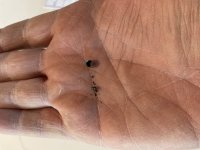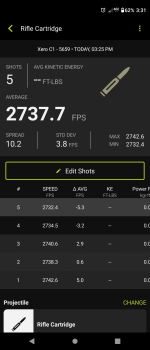Went to the 600yd range in Bogalusa to test some Heavy and Light CCI 450 primers.
22Nosler AR-15, Berger 85.5, 31.7gr SB 6.5
Grouped some 3.62/3.63 light ones, and some 3.73/3.75 heavy ones, 5 each, shot round robin light first.
The light/ heavy individual velocities, Garmin Xero:
Light 2989.3
*Heavy 3039.3
*Light 2975.2
Heavy 3007.7
Light 2996.5
Heavy 3018.5
Light 2993.2
Heavy 3011.4
Light 2997.4
Heavy 3015.7
Went back 2 weeks later and did a larger sample with individual primer weights recorded and post fired primer weight.
15 light, 15 heavy. Shot round robin heavy first. 22N AR-15, Berger 85.5, 31.8gr SB 6.5
Weighing performed with an A&D EJ-54D2, on low range (0.005grain resolution)
Shot Order, Primer Weight, Fired Primer Weight, Weight Loss, Garmin Xero Muzzle Velocity.
1 -- 3.765, 3.400, 0.365, 3036.8
30 - 3.625, 3.375, 0.250, 2989.2
2 -- 3.760, 3.390, 0.370, 3042.7
29 - 3.625, 3.360, 0.265, 2989.0
3 -- 3.765, 3.385, 0.380, 3054.4
28 - 3.620, 3.360, 0.260, 2987.4
4 -- 3.775, 3.405, 0.370, 3058.4
27 - 3.615, 3.370, 0.245, 2993.1
5 -- 3.755, 3.395, 0.360, 3050.2
26 - 3.610, 3.360, 0.250, 2977.4
6 -- 3.755, 3.395, 0.360, 3046.2
25 - 3.630, 3.380, 0.250, 2996.3
7 -- 3.750, 3.395, 0.355, 3037.8
24 - 3.630, 3.370, 0.260, 2982.8
8 -- 3.750, 3.385, 0.365, 3047.0
23 - 3.630, 3.370, 0.260, 2992.5
9 -- 3.750, 3.390, 0.360, 3055.4
22 - 3.635, 3.370, 0.265, 2987.9
10 -- 3.750, 3.390, 0.360, 3029.2
21 - 3.635, 3.365, 0.270, 3021.1
11 -- 3.740, 3.380, 0.360, 3055.1
20 - 3.635, 3.360, 0.275, 3010.1
12 -- 3.730, 3.385, 0.345, 3053.5
19 - 3.630, 3.360, 0.270, 3010.3
13 -- 3.730, 3.380, 0.350, 3063.0
18 - 3.635, 3.360, 0.275, 3013.2
14 -- 3.730, 3.380, 0.350, 3032.3
17 - 3.635, 3.370, 0.265, 3003.1
15 -- 3.730, 3.385, 0.345, 3044.6
16 - 3.640, 3.375, 0.265 2999.9
Range of primers: 0.165 grains
Range as fired: 0.045 grains
Range of weight loss: 0.135 grains
Extreme Spread of all 30 shots, Garmin Xero muzzle velocities 85.6 fps.
Extreme Spread of 15 HEAVY 33.8fps SD 9.6
Extreme Spread of 15 LIGHT 43.7fps, SD 12
Picture of Shot Marker target of 10 shots 3/7/24 and first 10 shots on 3/21/24.
Shot marker was acting up (I think) on 3/24 ??? Note avg velocity and POI started shifting right.

Also posted on a couple other forums.
22Nosler AR-15, Berger 85.5, 31.7gr SB 6.5
Grouped some 3.62/3.63 light ones, and some 3.73/3.75 heavy ones, 5 each, shot round robin light first.
The light/ heavy individual velocities, Garmin Xero:
Light 2989.3
*Heavy 3039.3
*Light 2975.2
Heavy 3007.7
Light 2996.5
Heavy 3018.5
Light 2993.2
Heavy 3011.4
Light 2997.4
Heavy 3015.7
Went back 2 weeks later and did a larger sample with individual primer weights recorded and post fired primer weight.
15 light, 15 heavy. Shot round robin heavy first. 22N AR-15, Berger 85.5, 31.8gr SB 6.5
Weighing performed with an A&D EJ-54D2, on low range (0.005grain resolution)
Shot Order, Primer Weight, Fired Primer Weight, Weight Loss, Garmin Xero Muzzle Velocity.
1 -- 3.765, 3.400, 0.365, 3036.8
30 - 3.625, 3.375, 0.250, 2989.2
2 -- 3.760, 3.390, 0.370, 3042.7
29 - 3.625, 3.360, 0.265, 2989.0
3 -- 3.765, 3.385, 0.380, 3054.4
28 - 3.620, 3.360, 0.260, 2987.4
4 -- 3.775, 3.405, 0.370, 3058.4
27 - 3.615, 3.370, 0.245, 2993.1
5 -- 3.755, 3.395, 0.360, 3050.2
26 - 3.610, 3.360, 0.250, 2977.4
6 -- 3.755, 3.395, 0.360, 3046.2
25 - 3.630, 3.380, 0.250, 2996.3
7 -- 3.750, 3.395, 0.355, 3037.8
24 - 3.630, 3.370, 0.260, 2982.8
8 -- 3.750, 3.385, 0.365, 3047.0
23 - 3.630, 3.370, 0.260, 2992.5
9 -- 3.750, 3.390, 0.360, 3055.4
22 - 3.635, 3.370, 0.265, 2987.9
10 -- 3.750, 3.390, 0.360, 3029.2
21 - 3.635, 3.365, 0.270, 3021.1
11 -- 3.740, 3.380, 0.360, 3055.1
20 - 3.635, 3.360, 0.275, 3010.1
12 -- 3.730, 3.385, 0.345, 3053.5
19 - 3.630, 3.360, 0.270, 3010.3
13 -- 3.730, 3.380, 0.350, 3063.0
18 - 3.635, 3.360, 0.275, 3013.2
14 -- 3.730, 3.380, 0.350, 3032.3
17 - 3.635, 3.370, 0.265, 3003.1
15 -- 3.730, 3.385, 0.345, 3044.6
16 - 3.640, 3.375, 0.265 2999.9
Range of primers: 0.165 grains
Range as fired: 0.045 grains
Range of weight loss: 0.135 grains
Extreme Spread of all 30 shots, Garmin Xero muzzle velocities 85.6 fps.
Extreme Spread of 15 HEAVY 33.8fps SD 9.6
Extreme Spread of 15 LIGHT 43.7fps, SD 12
Picture of Shot Marker target of 10 shots 3/7/24 and first 10 shots on 3/21/24.
Shot marker was acting up (I think) on 3/24 ??? Note avg velocity and POI started shifting right.
Also posted on a couple other forums.
Last edited:



